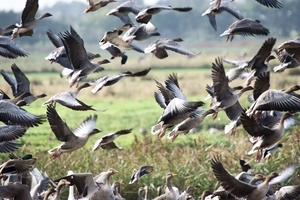Pink-footed goose
 This month I thought I would put the vote to the public as to what my October Species of the Month should be, so I put a poll up of two species that are notable this month on Twitter: the red deer due to the rut and the pink-footed goose because of their migration to our shores, and the favourite came back as the pink-footed goose at 62.1% – so here we are!
This month I thought I would put the vote to the public as to what my October Species of the Month should be, so I put a poll up of two species that are notable this month on Twitter: the red deer due to the rut and the pink-footed goose because of their migration to our shores, and the favourite came back as the pink-footed goose at 62.1% – so here we are!
The pink-footed goose (Anser brachyrhynchus) is one of our smaller geese, smaller than a mute swan but bigger than a mallard to put it into context, with a wingspan of 1.5m and weighing around 2.5kg. They have a relatively short neck; rounded head; and short, stubby, pink-banded bill; and have characteristic rose-pink legs, which best identify these compact, dark-headed geese.
They are highly vocal birds, well-known for its loud ‘wink-wink’ call that it often performs while flying in a flock, or ‘skein’, as opposed to the ‘honking’ calls of greylag and Canada geese. Do look out for the characteristic V-formation at this time of year that so many migrating birds use, as the pink-footed geese move about a lot during the winter, with flocks flying from Scotland to Lancashire to Norfolk and back in a few days, and listen out to their calls, which are higher-pitched and shriller than the larger grey geese.
The pink-footed goose is one of six species in the genus Anser (so-called grey geese) that occur in Europe, which breeds on the Arctic tundra of Iceland, East Greenland and Svalbard. The pink-footed goose alone incubates the clutch of 3-5 eggs for about 26 days. She lays in the open, but the gander remains with her, and both parents rear the goslings. The goslings will stay with their parents until the following spring.
Having spent the brief Arctic summer nesting in central Iceland, pink-footed geese take to open water and spend 25 days afloat, moulting their wing feathers before their flight south to their winter grounds. One mid-autumn day when the conditions are perfect, with the wind in the right direction, and temperature and food levels dropping, pink-footed families take off. Into the North Atlantic they fly, making landfall on the Faroe Islands six hours later, resting for a day before taking off again towards British shores. A day later, they land on our coasts in October.
Most of the population winters in Britain from October, with flocks of many thousands of birds found principally in eastern Scotland, the Solway, Lancashire and Norfolk, feeding on our wetland and farmland habitats. About 360,000 to 400,000 individuals spend the winter here, making it an important destination for this bird, before returning to their nesting site in March/April.
Numbers have increased considerably in the last 40 years. Nevertheless, they are classified in the UK as Amber under the Birds of Conservation Concern 4: the Red List for Birds (2021), as 90-100% of our wintering population is found at ten or fewer sites, making-up 70-80% of the European population.
So where is best to see these birds? You can see pink-footed geese near large estuaries, such as on the east Scottish coast, the Wash, the Ribble and the Solway, or on surrounding farmland where birds go in the day to feed.
Here are some hotspots if you are so inclined: Gibraltar Point (Lincolnshire), Holme Dunes (Norfolk), Cley Marshes (Norfolk), East Chevington (Northumberland), Spurn National Nature Reserve (Yorkshire), North Cave Wetlands (Yorkshire), Staveley Nature Reserve (Yorkshire).
Flocks roost overnight on the open water, returning to land at dawn to feed on the surrounding farmland. They then move on to other feeding grounds further south later in the year, in Lancashire and East Anglia.
So, keep your eyes skywards, as a skein of high-flying geese fly over your head chattering “wink-wink” to each other, it could well be a pink-footed goose, and you never know – you might see the same bird year on year as they have an average lifespan of about eight years!
Megan Lock
Advisory
Photo credit: Stephen Gidley